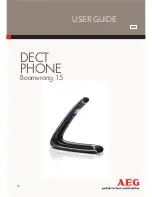
Introduction
9
Access Codes
Access codes are numbers assigned to certain features in your teleset
system. When you use these features, you have to dial the access code first.
One common example is dialing a number (such as “9”) before making an
outside call.
There are two kinds of access codes:
• System access codes: These come with your telephone system and are
identified in this User’s Guide by a bold number in parentheses. For
example: “Dial the Callback access code (2).” In this example, “2” is the
System access code for Callback (see page 19).
• Local access codes: These are assigned by your System Administrator.
For example, your teleset’s paging system accommodates up to eight
paging zones. Each zone is assigned its own code. Your System
Administrator makes these assignments.
Ask your System Administrator for the various access codes in your system.
The features in this User’s Guide provide empty boxes where you can note
access codes (or use the Access Code table in the Appendix, or on the Quick
Reference Card).
Confirmation Tones and Error Tones
A confirmation tone (often followed by a dial tone) indicates you have
successfully completed a step in setting up or using a feature, such as parking
or setting up call forwarding.
Once familiar with a feature, you can choose to ignore the confirmation tones
and dial straight through. An error tone alerts you if you dial incorrectly or have
timed out. See the Appendix for a list of audible tones that accompany set-up
and use of ClearCom features.
The Pedestal
Your ClearCom teleset (and the BEM24) has an adjustable pedestal to
support your teleset and allow you to select the most comfortable viewing
















































